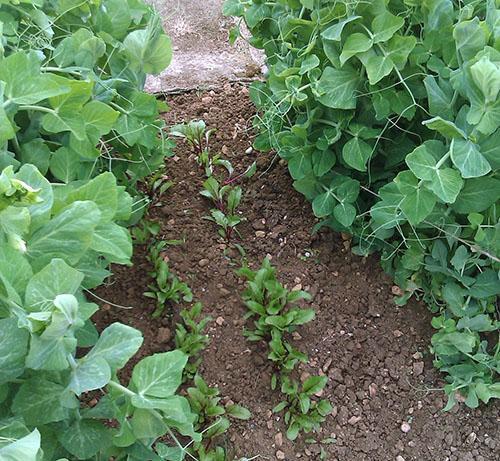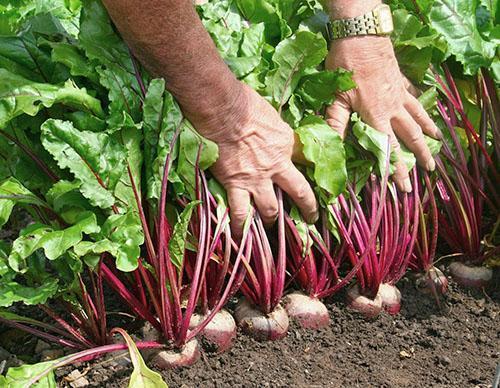Why beets don't grow in the garden - an overview of the main reasons
 Beetroot, which is quite easy to grow by regulars of garden beds, sometimes presents unpleasant surprises to summer residents. Even experienced gardeners can hear complaints about the death of only developing plants, yellowing or reddening of foliage, slowed growth of root crops and deterioration in their quality.
Beetroot, which is quite easy to grow by regulars of garden beds, sometimes presents unpleasant surprises to summer residents. Even experienced gardeners can hear complaints about the death of only developing plants, yellowing or reddening of foliage, slowed growth of root crops and deterioration in their quality.
What are these problems associated with? What to do if beets grow poorly and how to maintain an irreplaceable vegetable crop?
There can be several reasons for the lagging of beets in growth, lethargy and unusual type of tops, as well as the bad taste of the harvested root vegetables. And with their timely identification with the help of care and feeding of beets, it is not difficult to quickly correct the situation and harvest a good harvest by autumn.
The problem with the selection of a site for beet beds

If the plot is small, this garden dweller can be allocated a place between nightshade crops such as eggplants and peppers. Beets feel good next to onions and garlic, plantings cucumbers, squash and squash, in the aisles of early peas and asparagus beans.
If radishes or radishes, Swiss chard or any cabbage were grown in the garden in the previous season, then the reason why beets do not grow in the garden should be sought in violation of the rules of crop rotation.
Poor quality, low yield of root crops and reddening of foliage can be caused by excessive acidity of the soil. If this is true, then dolomite flour is introduced to the planting site of the garden crop, which solves the problem. However, overdoing it is also not worth it. Excessive lime can cause another problem - scab, which also affects the quality of the beets in a bad way.
What if the beets do not grow well immediately after sowing?
 Problems with the growth and formation of root crops in beets can begin soon after sowing. Why do beets grow poorly, and what should a gardener do in this situation?
Problems with the growth and formation of root crops in beets can begin soon after sowing. Why do beets grow poorly, and what should a gardener do in this situation?
When preparing the beds for beets, the soil is dug to a depth of 20-25 cm and organic matter is introduced in the fall at the rate of 15-20 kg compost or humus per square meter. If the culture is sown before winter, then organic matter is added during sowing in the amount of 5-6 kg per meter, in the spring the seedlings receive 30 grams of urea. The amount of mineral fertilizers is taken at the rate of 30 grams of potassium chloride and superphosphate per meter of the garden.
Proper care and early feeding of the beets is especially important. Failure to obtain nutrients necessary for a plant, especially with a lack of moisture, can cause weakening of seedlings, delay in their development and a sharp drop in yield.
If the plants have not received what they need when planting, you need to compensate for this omission as soon as possible.
However, both over-feeding and increased care of beets are sometimes harmful.The introduction of fresh manure for crops causes a severe burn of the delicate tissue of sprouts and seedlings, therefore, nitrogen fertilizing is safer to carry out in the form of watering with green infusion or in foliar form.
 The quality of seedlings and their further development are also influenced by the timing of sowing:
The quality of seedlings and their further development are also influenced by the timing of sowing:
- If the seeds begin to revive at + 4 ° C, and further growth will occur at 16-23 ° C and regular watering, then there is nothing to fear. Seedlings will appear on time and produce high-quality large roots.
- If the seeds are embedded in unheated soil, have fallen into frost, or the beginning of the growing season fell on a hot dry time, then the probability of the formation of peduncles, not root crops, is high.
One of the reasons why beets do not grow in the garden is a lack or excess of moisture.
We must not forget about watering beds, during which 15–20 liters of moisture should fall on a square meter. But here, too, there are some peculiarities:
- If young plants, beginning to form a root crop, react sharply to dry soil, weaken and wither, then watering quickly returns them vitality.
- In the last month before harvesting, excess moisture negatively affects the sweetness of root crops and their quality.
The depth of planting seeds in the spring is 2–3 cm, during the autumn sowing they are sealed one centimeter deeper. If the seeds go deeper, the sprouts spend more energy to overcome the soil layer and eventually weaken.
What to do if beets grow poorly already in spring? Pre-soaking the seeds in warm water or a solution of trace elements helps to speed up germination and give the sprouts strength. Since large beet seeds are, in fact, several combined seeds, the thinning of the emerging seedlings is of no less importance.
If the culture is grown on the site in a seedling way, transplanting requires extreme caution, because the slightest damage to the root system will immediately affect the development of the plant and the formation of the beet root crop.
 The death of very young plants is sometimes caused by root eater, a disease caused by a harmful fungus. The stem of an infected seedling in the root zone turns black and dries up. How to feed the beets for the growth of seedlings and their health? At the first signs of the disease and for prevention, the beds are treated with phytosporin, while not forgetting to spud the beet plants and thin out.
The death of very young plants is sometimes caused by root eater, a disease caused by a harmful fungus. The stem of an infected seedling in the root zone turns black and dries up. How to feed the beets for the growth of seedlings and their health? At the first signs of the disease and for prevention, the beds are treated with phytosporin, while not forgetting to spud the beet plants and thin out.
 This procedure is carried out twice:
This procedure is carried out twice:
- during the period when the plant has given a couple of true leaves, one sprout is left for every 3-4 cm;
- when the beets already have 4–5 leaves, and the roots themselves reach the size of a 10-ruble coin, they increase the distance to 7–8 cm.
How to feed beets for growth?
 Like other garden crops, beets must receive minerals. How to fertilize beets, and in what time frame should the plant receive such fertilizing?
Like other garden crops, beets must receive minerals. How to fertilize beets, and in what time frame should the plant receive such fertilizing?
The main crop needs are potash, phosphorus and nitrogen fertilizers, the lack of which necessarily affects the yield.
 It is convenient to combine feeding beets with care, for example, weeding and watering. During the growing season, beet beds are fed twice:
It is convenient to combine feeding beets with care, for example, weeding and watering. During the growing season, beet beds are fed twice:
- The first fertilization occurs during the first weeding and consists of urea or another nitrogen-containing product, at the rate of 10 grams per square meter.
- The second feeding can be done when the tops of neighboring plants are closed. At this time, 8 grams of superphosphate and 10 grams of potassium chloride are applied per meter of planting.
 How to feed beets for foliage growth? At the beginning of summer, nitrogen fertilization from mullein infusion or green fertilizer can push the formation of tops, but such a remedy cannot be abused. The closer to the end of the growing season, the greater the tendency of beets to accumulate nitrogen in root crops, and this negatively affects their taste and storage ability.
How to feed beets for foliage growth? At the beginning of summer, nitrogen fertilization from mullein infusion or green fertilizer can push the formation of tops, but such a remedy cannot be abused. The closer to the end of the growing season, the greater the tendency of beets to accumulate nitrogen in root crops, and this negatively affects their taste and storage ability.
Summer care of beets and fertilizing plantings with minerals and trace elements help to get a bountiful harvest in autumn.
The culture is especially sensitive to the deficiency of sodium, boron, copper and molybdenum. The deficiency can be compensated for by soaking the seeds at the germination stage, and then in the form of foliar dressing.